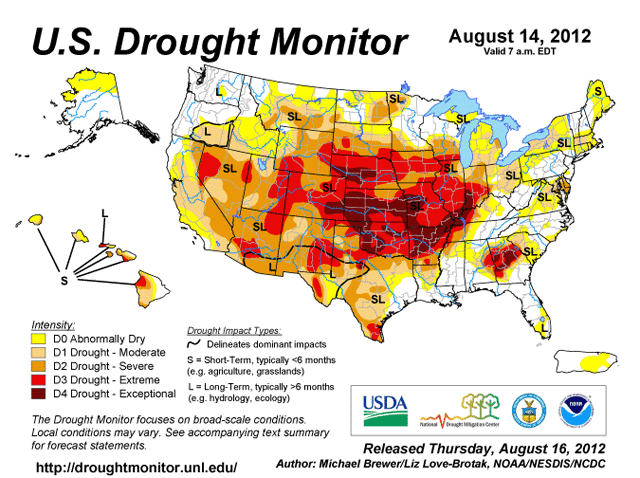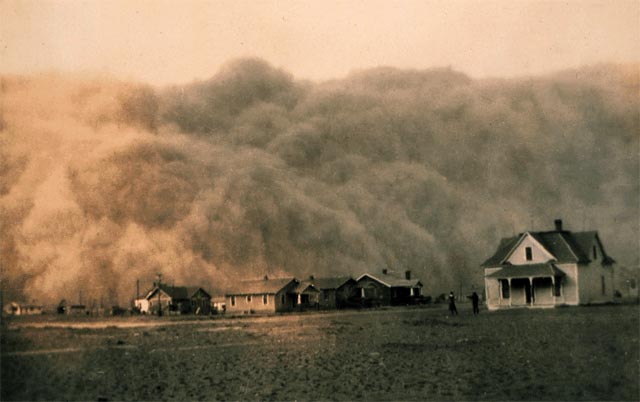The Shape Of Droughts To Come: 2012 Versus The 1930s Dust Bowl
The United States will suffer a series of severe droughts in the next two decades, according to a new study published in the journal Nature Climate Change. Moreover, global warming will play an increasingly important role in their abundance and severity, claims Aiguo Dai, the study’s author.
His findings bolster conclusions from climate models used by researchers around the globe that have predicted severe and widespread droughts in coming decades over many land areas…
“We can now be more confident that the models are correct,” Dai said, “but unfortunately, their predictions are dire.”

August 14, 2012 drought conditions showed historic levels of drought across the U.S., with 62% of the contiguous U.S. experiencing moderate or greater drought, and 46% of the county experiencing severe or greater drought. Image credit: U.S. Drought Monitor.
The great U.S. drought of 2012 remained about the same size and intensity over the past week, said NOAA in their weekly U.S. Drought Monitor report issued Thursday, August 16. The area of the contiguous U.S. covered by drought remained constant at 62%, and the area covered by severe or greater drought also remained constant at 46%. However, the area covered by the highest level of drought–exceptional–increased by 50%, from 4% to 6%.
Large expansions of exceptional drought occurred over the heart of America’s grain producing areas, in Kansas, Nebraska, Oklahoma, and Missouri. The new NOAA State of the Climate Drought report for July 2012 shows that the 2012 drought is 5th greatest in U.S. history, and the worst in 56 years. The top five years for area of the contiguous U.S. covered by moderate or greater drought:
1.Jul 1934, 80%
2.Dec 1939, 60%
3.Jul 1954, 60%
4.Dec 1956, 58%
5.Jul 2012, 57%
The top five years for the area of the contiguous U.S. covered by severe or greater drought:
1.Jul 1934, 63%
2.Sep 1954, 50%
3.Dec 1956, 46%
4.Aug 1936, 43%
5.Jul 2012, 38%
Comparison with the great Dust Bowl droughts of the 1930s
An important fact to remember is that the 2012 drought is–so far–only a one-year drought. Recall that 2011 saw record rains that led to unprecedented flooding on the Mississippi, Ohio, and Missouri Rivers. In contrast, the great droughts of the 1950s and 1930s were multi-year droughts. The Dust Bowl drought of the 1930s lasted up to eight years in some places, with the peak years being 1934, 1936, and 1939 – 1940. Once the deep soil dries out, it maintains a memory of past drought years. This makes is easier to have a string of severe drought years. Since the deep soil this summer still maintains the memory of the very wet year of 2011, the 2012 drought will be easier to break than the Dust Bowl droughts of the 1930s were.
In addition, a repeat of the dust storms of the 1930s Dust Bowl is much less likely now, due to improved farming practices. In a 2009 paper titled, Amplification of the North American “Dust Bowl” drought through human-induced land degradation, a team of scientists led by Benjamin Cook of the Lamont-Doherty Earth Observatory explained the situation:
During the 1920s, agriculture in the United States expanded into the central Great Plains. Much of the original, drought-resistant prairie grass was replaced with drought-sensitive wheat. With no drought plan and few erosion-control measures in place, this led to large-scale crop failures at the initiation of the drought, leaving fields devegetated and barren, exposing easily eroded soil to the winds. This was the source of the major dust storms and atmospheric dust loading of the period on a level unprecedented in the historical record.

Figure 2. Black Sunday: On April 14, 1935 a “Black Blizzard” hit Oklahoma and Texas with 60 mph winds, sweeping up topsoil loosened by the great Dust Bowl drought that began in 1934.
The Dust Bowl drought and heat of the 1930s: partially human-caused
Using computer models of the climate, the scientists found that the Dust Bowl drought was primarily caused by below-average ocean temperatures in the tropical Pacific and warmer than average ocean temperatures in the Atlantic, which acted together to alter the path of the jet stream and bring fewer precipitation-bearing storms to the Central U.S. However, the full intensity of the drought and its spatial extent could not be explained by ocean temperature patterns alone.
Only when their model included the impact of losing huge amounts of vegetation in the Plains due to poor farming practices could the full warmth of the 1930s be simulated. In addition, only by including the impact of the dust kicked up by the great dust storms of the Dust Bowl, which blocked sunlight and created high pressure zones of sinking air that discouraged precipitation, could the very low levels of precipitation be explained. The Dust Bowl drought had natural roots, but human-caused effects made the drought worse and longer-lasting.
The fact that we are experiencing a drought in 2012 comparable to the great Dust Bowl drought of the 1930s–without poor farming practices being partially to blame–bodes ill for the future of drought in the U.S. With human-caused global warming expected to greatly increase the intensity and frequency of great droughts like the 2012 drought in coming decades, we can expect drought to cause an increasing amount of damage and economic hardship for the U.S. Since the U.S. is the world’s largest food exporter, this will also create an increasing amount of hardship and unrest in developing countries that rely on food imports.
His findings bolster conclusions from climate models used by researchers around the globe that have predicted severe and widespread droughts in coming decades over many land areas…
“We can now be more confident that the models are correct,” Dai said, “but unfortunately, their predictions are dire.”

August 14, 2012 drought conditions showed historic levels of drought across the U.S., with 62% of the contiguous U.S. experiencing moderate or greater drought, and 46% of the county experiencing severe or greater drought. Image credit: U.S. Drought Monitor.
The great U.S. drought of 2012 remained about the same size and intensity over the past week, said NOAA in their weekly U.S. Drought Monitor report issued Thursday, August 16. The area of the contiguous U.S. covered by drought remained constant at 62%, and the area covered by severe or greater drought also remained constant at 46%. However, the area covered by the highest level of drought–exceptional–increased by 50%, from 4% to 6%.
Large expansions of exceptional drought occurred over the heart of America’s grain producing areas, in Kansas, Nebraska, Oklahoma, and Missouri. The new NOAA State of the Climate Drought report for July 2012 shows that the 2012 drought is 5th greatest in U.S. history, and the worst in 56 years. The top five years for area of the contiguous U.S. covered by moderate or greater drought:
1.Jul 1934, 80%
2.Dec 1939, 60%
3.Jul 1954, 60%
4.Dec 1956, 58%
5.Jul 2012, 57%
The top five years for the area of the contiguous U.S. covered by severe or greater drought:
1.Jul 1934, 63%
2.Sep 1954, 50%
3.Dec 1956, 46%
4.Aug 1936, 43%
5.Jul 2012, 38%
Comparison with the great Dust Bowl droughts of the 1930s
An important fact to remember is that the 2012 drought is–so far–only a one-year drought. Recall that 2011 saw record rains that led to unprecedented flooding on the Mississippi, Ohio, and Missouri Rivers. In contrast, the great droughts of the 1950s and 1930s were multi-year droughts. The Dust Bowl drought of the 1930s lasted up to eight years in some places, with the peak years being 1934, 1936, and 1939 – 1940. Once the deep soil dries out, it maintains a memory of past drought years. This makes is easier to have a string of severe drought years. Since the deep soil this summer still maintains the memory of the very wet year of 2011, the 2012 drought will be easier to break than the Dust Bowl droughts of the 1930s were.
In addition, a repeat of the dust storms of the 1930s Dust Bowl is much less likely now, due to improved farming practices. In a 2009 paper titled, Amplification of the North American “Dust Bowl” drought through human-induced land degradation, a team of scientists led by Benjamin Cook of the Lamont-Doherty Earth Observatory explained the situation:
During the 1920s, agriculture in the United States expanded into the central Great Plains. Much of the original, drought-resistant prairie grass was replaced with drought-sensitive wheat. With no drought plan and few erosion-control measures in place, this led to large-scale crop failures at the initiation of the drought, leaving fields devegetated and barren, exposing easily eroded soil to the winds. This was the source of the major dust storms and atmospheric dust loading of the period on a level unprecedented in the historical record.

Figure 2. Black Sunday: On April 14, 1935 a “Black Blizzard” hit Oklahoma and Texas with 60 mph winds, sweeping up topsoil loosened by the great Dust Bowl drought that began in 1934.
The Dust Bowl drought and heat of the 1930s: partially human-caused
Using computer models of the climate, the scientists found that the Dust Bowl drought was primarily caused by below-average ocean temperatures in the tropical Pacific and warmer than average ocean temperatures in the Atlantic, which acted together to alter the path of the jet stream and bring fewer precipitation-bearing storms to the Central U.S. However, the full intensity of the drought and its spatial extent could not be explained by ocean temperature patterns alone.
Only when their model included the impact of losing huge amounts of vegetation in the Plains due to poor farming practices could the full warmth of the 1930s be simulated. In addition, only by including the impact of the dust kicked up by the great dust storms of the Dust Bowl, which blocked sunlight and created high pressure zones of sinking air that discouraged precipitation, could the very low levels of precipitation be explained. The Dust Bowl drought had natural roots, but human-caused effects made the drought worse and longer-lasting.
The fact that we are experiencing a drought in 2012 comparable to the great Dust Bowl drought of the 1930s–without poor farming practices being partially to blame–bodes ill for the future of drought in the U.S. With human-caused global warming expected to greatly increase the intensity and frequency of great droughts like the 2012 drought in coming decades, we can expect drought to cause an increasing amount of damage and economic hardship for the U.S. Since the U.S. is the world’s largest food exporter, this will also create an increasing amount of hardship and unrest in developing countries that rely on food imports.
You can return to the main Market News page, or press the Back button on your browser.

